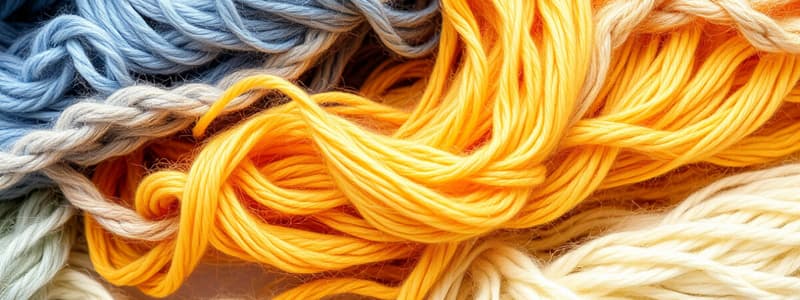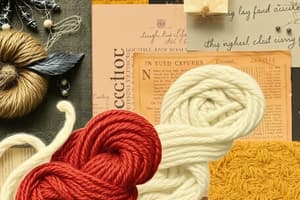Podcast
Questions and Answers
What are the 4 chemical classifications of fibers?
What are the 4 chemical classifications of fibers?
- Synthetic (correct)
- Mineral (correct)
- Cellulose (correct)
- Protein (correct)
What are cellulose fibers?
What are cellulose fibers?
Fibers that come from a plant, such as cotton.
What are protein fibers?
What are protein fibers?
Fibers that come from an animal, such as wool.
What are mineral fibers?
What are mineral fibers?
What are synthetic fibers?
What are synthetic fibers?
How does cotton react to contact with water?
How does cotton react to contact with water?
What are 3 main advantages of cotton fiber?
What are 3 main advantages of cotton fiber?
What fabric has been considered the 'fabric of our lives' for more than 7,000 years?
What fabric has been considered the 'fabric of our lives' for more than 7,000 years?
Are cotton fibers staple or filament in length?
Are cotton fibers staple or filament in length?
What percentage of the world's fiber consumption does cotton make up?
What percentage of the world's fiber consumption does cotton make up?
What 3 countries are major producers of cotton?
What 3 countries are major producers of cotton?
What part of the plant does the cotton fiber come from?
What part of the plant does the cotton fiber come from?
What is the highest grade of cotton?
What is the highest grade of cotton?
What does 'cleanliness' refer to when talking about cotton?
What does 'cleanliness' refer to when talking about cotton?
What are some examples of better quality cottons?
What are some examples of better quality cottons?
How do cottons such as Sea Island, Pima, Egyptian, and Supima differ in quality from regular Upland or Alcala cotton?
How do cottons such as Sea Island, Pima, Egyptian, and Supima differ in quality from regular Upland or Alcala cotton?
What is colorgrown cotton?
What is colorgrown cotton?
What is organic cotton?
What is organic cotton?
What is a bast fiber?
What is a bast fiber?
Flashcards are hidden until you start studying
Study Notes
Fiber Classifications
- Four chemical classifications of fibers: cellulose, protein, mineral, synthetic.
Natural Fibers
- Cellulose fibers: Plant-derived fibers; example includes cotton.
- Protein fibers: Animal-derived fibers; example includes wool.
- Mineral fibers: Sourced from minerals; example includes glass.
Synthetic Fibers
- Created through chemical processes; example includes nylon.
Cotton Characteristics
- Cotton is hydrophilic, meaning it absorbs water and becomes 30% stronger when wet.
- Main advantages of cotton fiber are absorbency, breathability, and a soft feel.
- Considered the "fabric of our lives" for over 7,000 years, highlighting its historical significance.
- Cotton fibers are classified as staple fibers, meaning they are relatively short.
- Approximately 31% of the world's fiber consumption consists of cotton.
Cotton Production
- Major cotton-producing countries include India, China, and the United States.
- Cotton fibers originate from the boll or seed of the cotton plant.
Quality of Cotton
- The highest grade of cotton is white cotton, known for its purity.
- "Cleanliness" in cotton refers to the amount of leaves and stems left in the fiber, affecting its quality.
- Examples of high-quality cottons with longer staple fibers include Sea Island, Pima, Egyptian, and Supima.
- Higher quality cottons such as Sea Island and Pima are silkier, stronger, and more lustrous compared to regular Upland or Alcala cotton.
Special Types of Cotton
- Colorgrown cotton: Naturally grown in various colors, eliminating the need for dyeing.
- Organic cotton: Cultivated with minimal environmental impact, avoiding toxic fertilizers and pesticides.
Bast Fibers
- Definition pending to elaborate on plant fibers obtained from specific plants.
Studying That Suits You
Use AI to generate personalized quizzes and flashcards to suit your learning preferences.




